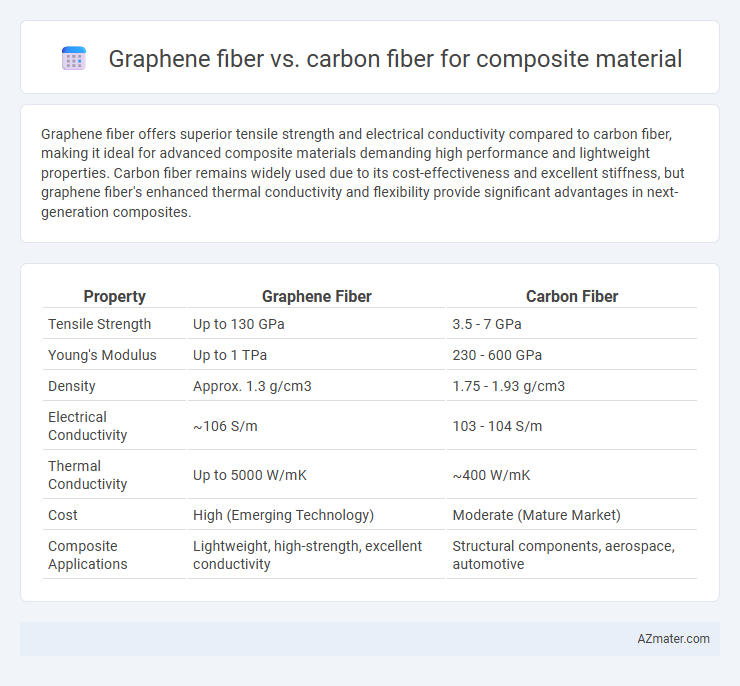Graphene fiber offers superior tensile strength and electrical conductivity compared to carbon fiber, making it ideal for advanced composite materials demanding high performance and lightweight properties. Carbon fiber remains widely used due to its cost-effectiveness and excellent stiffness, but graphene fiber's enhanced thermal conductivity and flexibility provide significant advantages in next-generation composites.
Table of Comparison
| Property | Graphene Fiber | Carbon Fiber |
|---|---|---|
| Tensile Strength | Up to 130 GPa | 3.5 - 7 GPa |
| Young's Modulus | Up to 1 TPa | 230 - 600 GPa |
| Density | Approx. 1.3 g/cm3 | 1.75 - 1.93 g/cm3 |
| Electrical Conductivity | ~106 S/m | 103 - 104 S/m |
| Thermal Conductivity | Up to 5000 W/mK | ~400 W/mK |
| Cost | High (Emerging Technology) | Moderate (Mature Market) |
| Composite Applications | Lightweight, high-strength, excellent conductivity | Structural components, aerospace, automotive |
Introduction to Composite Materials
Composite materials combine two or more distinct substances to create a material with superior mechanical properties, such as enhanced strength, stiffness, and durability. Graphene fiber and carbon fiber both serve as high-performance reinforcement materials within composites, offering exceptional tensile strength and lightweight characteristics. Graphene fiber provides improved electrical conductivity and flexibility compared to traditional carbon fiber, making it particularly advantageous for next-generation composite applications in aerospace, automotive, and wearable technologies.
Overview of Graphene Fiber Technology
Graphene fiber technology leverages the exceptional mechanical, electrical, and thermal properties of graphene to create composite materials with enhanced strength, flexibility, and conductivity compared to traditional carbon fibers. These fibers exhibit higher tensile strength and better energy absorption capabilities, making them ideal for advanced aerospace, automotive, and wearable electronics applications. Research focuses on scalable production methods and optimizing fiber alignment to maximize graphene's intrinsic properties within composite matrices.
Key Properties of Carbon Fiber
Carbon fiber offers exceptional tensile strength, low density, and high stiffness, making it a preferred choice for composite materials in aerospace, automotive, and sports equipment industries. Its thermal stability and resistance to chemical corrosion further enhance durability and performance under extreme conditions. While graphene fiber shows potential in conductivity and flexibility, carbon fiber's well-established mechanical properties and cost-effectiveness continue to dominate composite material applications.
Mechanical Strength Comparison
Graphene fiber exhibits superior tensile strength and Young's modulus compared to carbon fiber, making it a promising material for high-performance composite applications. While carbon fiber typically achieves tensile strengths of around 3.5 GPa and elastic moduli of 230-600 GPa, graphene fibers can exceed tensile strengths of 5 GPa and moduli above 600 GPa under optimized conditions. The enhanced mechanical properties of graphene fiber contribute to increased durability and lightweight composites in aerospace, automotive, and sports equipment industries.
Weight and Density Differences
Graphene fiber exhibits significantly lower density, approximately 1.3-1.5 g/cm3, compared to carbon fiber's density of about 1.75-1.93 g/cm3, resulting in lighter composite materials. The reduced weight of graphene fiber composites enhances structural efficiency and fuel savings in aerospace and automotive applications. Despite carbon fiber's higher strength-to-weight ratio, graphene fiber's superior lightweight properties offer promising advancements in next-generation composite designs.
Electrical and Thermal Conductivity
Graphene fiber exhibits significantly higher electrical conductivity compared to carbon fiber, making it ideal for applications requiring efficient electrical signal transmission in composite materials. Thermal conductivity in graphene fiber also surpasses that of carbon fiber, providing superior heat dissipation properties crucial for thermal management in advanced composites. These enhanced conductive characteristics position graphene fiber as a promising material for next-generation multifunctional composites in aerospace, electronics, and energy storage industries.
Manufacturing Processes and Scalability
Graphene fiber manufacturing involves chemical vapor deposition (CVD) and wet spinning techniques, enabling high purity and flexibility but currently faces scalability challenges due to complex synthesis and high costs. Carbon fiber is produced through well-established processes like polyacrylonitrile (PAN) precursor stabilization, carbonization, and surface treatment, allowing mass production with consistent quality and lower cost-effectiveness for large-scale composite manufacturing. Scalability for carbon fiber surpasses graphene fiber, making it the preferred choice for industries requiring extensive composite material production despite graphene's superior strength-to-weight ratio.
Durability and Environmental Resistance
Graphene fiber exhibits superior durability compared to carbon fiber, with enhanced tensile strength and resistance to micro-cracking under stress. Its exceptional environmental resistance includes increased resistance to UV radiation, moisture, and chemical corrosion, making it ideal for harsh conditions. Carbon fiber, while strong and lightweight, is more susceptible to degradation from prolonged UV exposure and moisture infiltration, necessitating protective coatings in composite applications.
Cost Analysis and Economic Viability
Graphene fiber offers superior strength-to-weight ratio and electrical conductivity compared to carbon fiber, but its production costs remain significantly higher due to complex manufacturing processes and limited large-scale availability. Carbon fiber remains more economically viable for widespread use in composites, benefiting from established supply chains and mature production technologies that keep costs relatively low. While graphene fiber shows promising performance advantages, current cost structures limit its competitiveness, positioning carbon fiber as the preferred choice in cost-sensitive composite material applications.
Future Trends and Industry Applications
Graphene fiber offers superior electrical conductivity, increased tensile strength, and enhanced flexibility compared to traditional carbon fiber, positioning it as a revolutionary material in composite manufacturing. Industries such as aerospace, automotive, and sports equipment are increasingly integrating graphene fiber composites to achieve lighter, stronger, and more durable components. Future trends emphasize scalable production methods and hybrid composites combining graphene and carbon fibers to maximize performance and reduce costs.

Infographic: Graphene fiber vs Carbon fiber for Composite material
 azmater.com
azmater.com